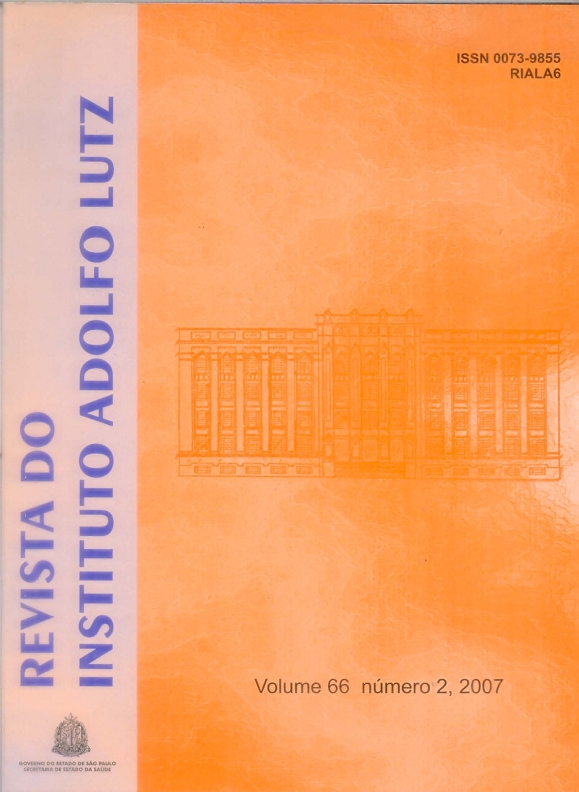Resumo
No Brasil, 90% dos pacientes renais crônicos dependem dos procedimentos de hemodiálise para remover produtos de degradação metabólica, excesso de água e de sais minerais do organismo, e para restaurar o equilíbrio ácido-base e eletrolítico. A água é o principal componente do tratamento por diálise e suas qualidades química e microbiológica são essenciais para evitar riscos adicionais ao paciente. As soluções para diálise e os equipamentos proporcionam ambientes adequados ao desenvolvimento microbiano, especialmente bactérias Gram-negativas. Além de bacteremias, os microrganismos Gram-negativos podem estar relacionados à ocorrência de reações pirogênicas. Este estudo teve por objetivo verificar a ocorrência de bactérias Gram-negativas não fermentadoras de glicose em 97 amostras de água tratada para diálise e 27 amostras de dialisatos, avaliadas entre junho de 2005 e dezembro de 2006. As bactérias Gram-negativas não fermentadoras de glicose foram detectadas em 29,6% das amostras de dialisatos e em 49,5% das amostras de água tratada. Nove espécies foram isoladas e identificadas, sendo a mais freqüente o complexo Burkholderia cepacia (59,0%), seguido de Stenotrophomonas maltophilia (13,1%).
Referências
1. Hoenick NA, Ronco C, Levin R. The importance of water quality and haemodialysis fluid composition. Blood Purif, 2006; 24: 11-8.
2. Silva AMM, Martins CTB, Ferraboli R, Jorgetti V, Romão Junior JE. Revisão/Atualização em Diálise: Água para hemodiálise. J Bras Nefrol, 1996; 18(2): 180-8.
3. Vorbeck-Meister I, Sommer R, Vorbeck F, Hörl WH. Quality of water used for haemodialysis: bacteriological and chemical parameters. Nephrol Dial Transplant, 1999; 14: 666-75.
4. Pontoriero G, Pozzoni P, Andrulli S, Locatelli F. Thequality of dialysis water. Nephrol Dial Transplant, 2003;18 (suppl 7): vii21-5.
5. Morin P. Identification of the bacteriological contamination of a water treatment line used for haemodialysis and itsdisinfection. J Hosp Infect, 2000; 45: 218-24.
6. Hoenick NA, Levin R. The implications of water quality inhemodialysis. Semin Dial, 2003; 16(6): 492-7.
7. McFeters GA, Broadaway SC, Pyle BH, Egozy Y. Distribution of bacteria within operating laboratory water purification systems. Appl Environm Microbiol, 1993;59 (5): 1410-5.
8. Lebedo I. On-line preparation of solutions for dialysis: practical aspects versus safety and regulations. J Am Soc Nephrol, 2002; 13: S78-S83.
9. Roth VR, Jarvis WR. Outbreaks of infection and or pyrogenic reactions in dialysis patients. Semin Dial, 2000; 13 (2):92-6.
10. Favero MS. Role of the CDC in hemodialysis: an historical perspective. Semin Dial, 2000; 13 (2): 64-7.
11. Zunino P, Beltrán L, Zunino L, Méndez H, Percovich V et al. Microbiological quality of hemodialysis water in a three-yearmulticenter study in Uruguay. J Nephrol, 2002; 15:374-9.
12. Arvanitidou M, Vayona A, Spanakis N, Tsakris A. Occurrence and antimicrobial resistance of Gram-negative bacteria isolated in haemodialysis water and dialysate of renalunits: results of a Greek multicentre study. J Appl Microbiol,2003; 95: 180-5.
13. Saxena AK, Panhora BR. Haemodialysis catheter-related bloodstream infections: current treatmentoptions and strategies for prevention. Swiss Med Wkly,2005; 135:127-38.
14. Oie S, Kamiya A, Yoneda I, Uchiyama K, Tsuchida M, TakaiK et al. Microbial contamination of dialysate and itsprevention in haemodialysis units. J Hosp Infect, 2003;54: 115-9.
15. Cappelli G, Sereni L, Scialoja MG, Morselli M, Perrone S, Ciuffreda A et al. Effects of biofilm formation onhaemodialysis monitor disinfection. Nephrol Dial Transplant, 2003; 18: 2105-11.
16. Brasil, Leis e Decretos. Resolução RDC nº154 de 15 de junho de 2004. Estabelece o Regulamento Técnico para funcionamento dos Serviços de Diálise. Disponível em<http://e-legis.anvisa.gov.br/leisref/public/showAct.php?id=22875&word>. Acesso em 29 dedezembro de 2006.
17. American Public Health Association. Standard Methods for the examination of Water and Wasterwater. 20ª ed. Baltimore: United Book Press, Inc; 1998.
18. Pessoa GVA, Silva EAM. Meios de Rugai e lisina-motilidade combinados em um só tubo para identificação presuntiva de enterobactérias. Rev Inst Adolfo Lutz,1972; 32: 97-100.

Este trabalho está licenciado sob uma licença Creative Commons Attribution 4.0 International License.
Copyright (c) 2007 Adriana Bugno, Adriana Aparecida Buzzo Almódovar, Tatiana Caldas Pereira, Mariângela Tirico Auricchio
